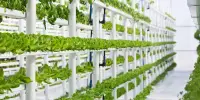The science and study of cultivating plants in an urban environment is known as urban horticulture. It is the activity of growing and producing plants in urban and suburban environments, including fruits, vegetables, herbs, and ornamental plants. It focuses on the practical use of horticulture in order to preserve and improve the surrounding urban environment. It entails producing food and vegetation in small spaces such as rooftops, balconies, community gardens, and small yards.
Because of the rising urbanization of society and the demand for sustainable and locally sourced food, urban horticulture has grown in popularity in recent years. With the global trend of urbanization, it has seen a rise in attention and works to research the harvest, aesthetic, architectural, recreational, and psychological uses and effects of plants in urban areas.
Here are some key aspects and benefits of urban horticulture:
- Food Production: It enables individuals and communities to grow their own fresh produce, decreasing the need for long-distance transportation and lowering the carbon footprint associated with food production.
- Environmental Benefits: Green spaces in cities help to reduce the urban heat island effect, enhance air quality, and provide home for wildlife. Plants absorb carbon dioxide and release oxygen, contributing to a better urban environment.
- Community Engagement: Communal gardens and urban horticulture programs promote social interaction, communal cohesion, and a sense of ownership and pride among participants. These areas are frequently used as teaching hubs where people may learn about gardening, nutrition, and sustainable practices.
- Local Food Security: It can enhance local food security by providing a source of fresh produce within urban areas. This can be especially valuable in areas with limited access to affordable, nutritious food.
- Economic Opportunities: Urban farming and horticulture initiatives can create job opportunities, stimulate local economies, and support small-scale agriculture businesses, such as urban farmers’ markets.
- Sustainable Practices: Many urban horticulturists practice sustainable gardening techniques, such as composting, rainwater harvesting, and organic farming methods, to minimize environmental impacts.
Education and Research
Urban horticulture allows for study and education in fields such as plant biology, soil science, and sustainable agriculture. It can also be used to educate people about the value of nature and gardening. It enhances the attractiveness and greenery of urban environments, making cities more aesthetically pleasing and enhancing citizens’ overall quality of life.
Small container gardens on apartment balconies to large-scale communal gardens and vertical farming systems are all examples of urban horticulture. It may be adjusted to the requirements and interests of the local community and is adaptable to varied urban areas. As urban populations rise, urban horticulture will undoubtedly play a larger part in sustainable urban development and food supply.
















